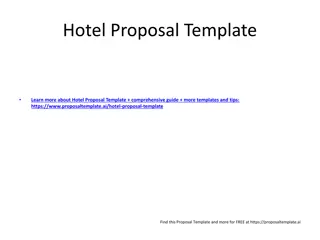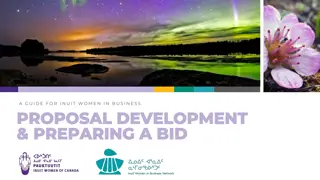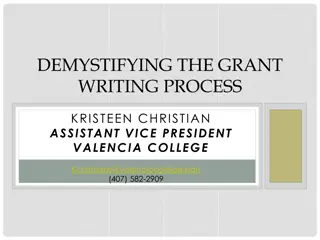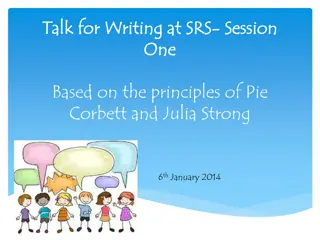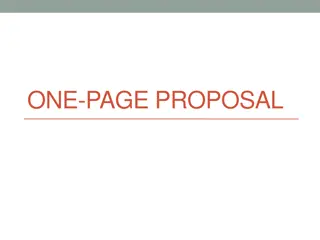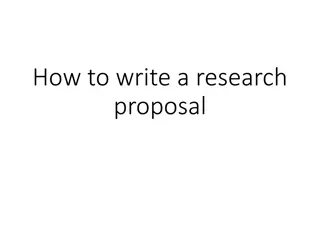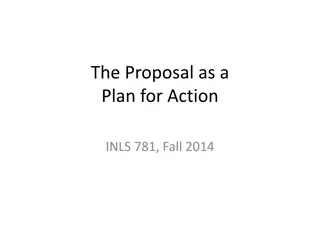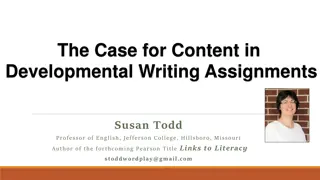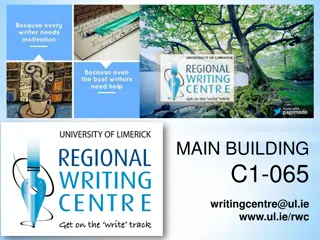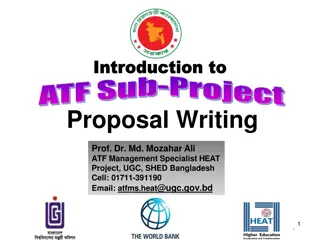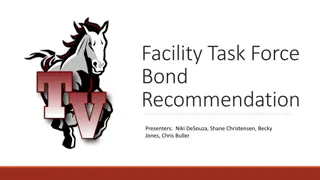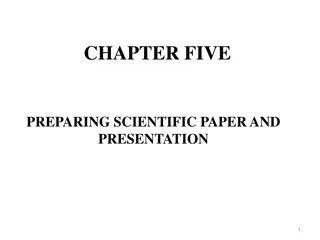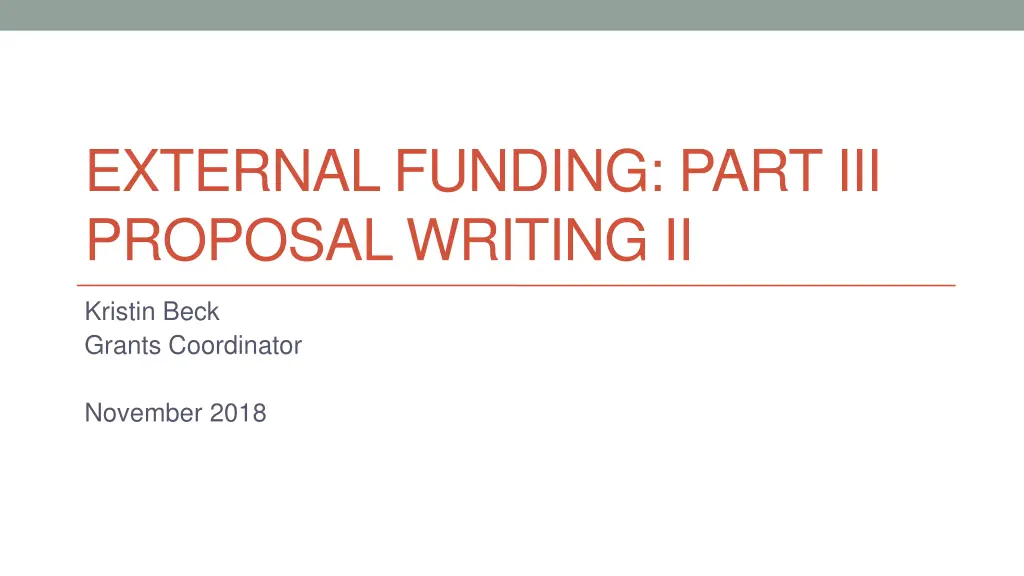
Effective Proposal Writing Techniques
Master the art of proposal writing with this comprehensive guide covering topics such as introduction, purpose, abstract, and pitfalls to avoid. Learn how to grab reviewers' attention, set clear goals, and make your proposal stand out. Perfect for aspiring grant writers and researchers.
Download Presentation

Please find below an Image/Link to download the presentation.
The content on the website is provided AS IS for your information and personal use only. It may not be sold, licensed, or shared on other websites without obtaining consent from the author. If you encounter any issues during the download, it is possible that the publisher has removed the file from their server.
You are allowed to download the files provided on this website for personal or commercial use, subject to the condition that they are used lawfully. All files are the property of their respective owners.
The content on the website is provided AS IS for your information and personal use only. It may not be sold, licensed, or shared on other websites without obtaining consent from the author.
E N D
Presentation Transcript
EXTERNAL FUNDING: PART III PROPOSAL WRITING II Kristin Beck Grants Coordinator November 2018
Agenda Introduction Overview/Summary Title Timeline Evaluation Logic Models Competitiveness Structure Common Pitfalls
INTRODUCTION The challenge of concision Aka: Summary, Overview
Introduction and Overview Opening sentence/paragraph should be unique to your project. Grab the reviewers attention. After reading the introduction, the reviewer should Have a basic understanding of the project Be convinced of the need Want more details
Introduction and Overview Section should contain: Long-term goals (your research agenda) Specific project goals Hypotheses or research questions Objectives and expected outcomes Overview of approach Statement of significance
Purpose Grab the reviewer s interest and generate enthusiasm Frame the goals and scope of your study Identify the need for and innovative features of the research and expected outcomes Demonstrate importance of the work Show you have what it takes
Abstract Assumptions Assume the reviewer is bored from reading dull proposals Assume the reviewer has already read more good proposals than can be funded Assume your proposal will be funded The abstract will be published What do you want the world to know about your project.
Reminders The most important part of your proposal A template or guide to the proposal Written for a non-technical audience The last section to revise
TITLES What s in a name?
Purpose of Titles Introduce reader to framework and perspective Prepare the reader for the desired focus Capture the reader s attention Reviewer may begin with the most intriguing titles Get the reviewer when freshest and most receptive
Titles Should Be Original Written in plain language Use active verbs that point to the outcome of the research Clear, concise, and meaningful Viewed as a work in progress
Writing Your Title List all appropriate elements and weave them into various permutations Rework your title to clarify, shorten, make more precise Ask yourself Is it understandable? Is it easy to guess the content of the proposal? Would a few word changes make it more interesting or effective to a non-specialist?
Titles of Projects submitted by NMU C3PO for Students (Coding and Circuits for Cultivating Potential and Opportunity for Students) An Assessment of the Effects of Mountain Biking in Marquette on Michigan s Ecotourism Economy: Co-Learning Plan Implementing a Student Support Services Program to Support First Generation, Low Income Students and Students with Disabilities Population and Habitat Use of Spruce Grouse (Falcipennis canadensis) in the Central Upper Peninsula of Michigan Supramolecular Catalyst Assembled through Aromatic Donor-acceptor Interaction and Its Application in Asymmetric Ring Opening Reactions of Epoxides
Digital Humanities Institute: Photovoice Stories Using Technology for Educator-Researchers (Digital HIPSTERs) STEP UP to MESS (Secondary Teacher Education for the Upper Peninsula in Mathematics, English Literacy, Science and Social Studies) Educator Evaluation Research and Evaluation Activities
Titles Include Dependent and independent variables Performance component represented by criterion task Treatment to be administered Model underlying the study
Titles Include Purpose of the study (can be implied) Study of relationship: Anthropometrics, Swimming Speed, and Shoulder-Girdle Strength Study of differences: Anthropometrics and Shoulder-Girdle Strength of Fast and Slow Swimmers. Any unusual contribution of the study Length or magnitude: Longitudinal Analysis of Human Short-Term Memory from Age 20 to Age 80 Creative method: Hand Preference in Telephone Use as a Measure of Limb Dominance and Laterality Unique sampling technique: Intelligence of Children Whose Parents Own Personal Computers. Unusual measurement site: Perceptual Judgment in a Weightless Environment: Report from the Space Shuttle.
Elements to Exclude Population, research design, instrumentation (unless they represent a substantial departure from similar studies) Eliminate redundancies Aspects of Comments on Study of Investigation of Inquiry into An Analysis of
Writing Your Title List all appropriate elements and weave them into various permutations. Rework your title to clarify, shorten, make more precise Ask yourself Is it understandable? Is it easy to guess the content of the proposal based on the title? Would a few word changes make it more interesting or effective to a non-specialist?
PULLING IT ALL TOGETHER Is your plan persuasive?
Capture and Keep Attention Organize Offer roadmaps to keep reader headed in the right direction Highlight Don t bury critical information Don t emphasize that are less important Funnel From the big picture to research specifics Focus Avoid information that detracts from or dilutes
Write with the Reviewers in Mind Reviewers: Are tired and overworked Probably wear bifocals May be reading your proposal at 2am Make it easy for them and they will love you Follow directions Clearly address review criteria Include lots of headings, figures, white space
Storytelling Tell a story that Unfolds in a way the reader can follow Doesn t violate the reader s sense of logic Makes the reader want to know what will happen next Communicate your excitement Good science is interesting
Specific measurable activities that will help solve the problem Clear connection between proposed project and sponsor s goals Proposal Logics Of the organization, individual, and project Differentiate from the competition Persuasion Applicant Credibility Proposal Psychologics Respond to the sponsor s emotional needs/values Display trust, energy, passion, ownership, and commitment
Return Without Review Inappropriate for funding by the agency Doesn t meet specific requirements (deadline) Submitted with insufficient lead time before the project is to begin Duplicate of a proposal already under review or already awarded Not substantially revised after previously reviewed and declined
Mechanical Problems Document not legible, logical and reader friendly Poor page space planning Too much text devoted to complex details or prior work Inadequate attention to proposed new effort Poor quality of writing Grandiose claims Convoluted reasoning Excessive repetition Grammatical errors
Methodological Problems Completely traditional approach with nothing unusual, intriguing, or clever Proposed method unsuited to the purpose of the research Overly ambitious given available time and resources Unclear in describing elements of the study
Personnel Problems Literature review reveals limited knowledge of the territory Project appears to be beyond PI s training, experience, ability, and resources No evidence of relationship with or support from essential collaborators The PI took highly partisan positions on issues and became vulnerable to reviewers bias
Cost-Benefit Problems Not an agency priority for this year Budget unrealistic Project cost appears greater than any possible benefit to be derived Uncertainty about future directions What is the theoretical or practical benefit that extends beyond the project? How will you use the project to continue work in this area?
Clearly identify novelty and distinguish your approach from others Consider both empirical and theoretical contributions that may emerge Show how your work will address concerns specific to the agency
Overall Strategies Remember the cornerstones of good research Important questions The best and most appropriate methods Appropriate analysis and application of results Synthesis and timely dissemination of results Promise success through Clarity of presentation Sharp focus on important problem Clearly defined, experimental model A few specific, testable hypotheses
Rejection Happens 75-90% of proposals are rejected Very few first applications are funded Re-submissions do succeed 1. 8% 2. 28% 3. 47%
Analyzing the Reviews Did the reviewers have particular concerns that you can address? Were the reviewers confused or unclear about your project? Were the reviewers unimpressed by the significance or novelty of your research idea? Be careful about chasing one comment by one reviewer look at the Panel Summary.
Call the Program Officer Be nice! Ask for clarification of reviewer comments Ask for advice Should you resubmit? Should you apply to a different program? What would strengthen your proposal?
Next Sessions November 28 WS2803 8:00am
Any Questions Kristin Beck krbeck@nmu.edu x1893


